2 Ways to Ferment Fresh Herbs
Fermented fresh herbs have an intensely fresh, tangy taste. Fermenting locks in the flavour and gives them a tangy zing from the lactic acid of the ferment. While perennial herbs like rosemary, oregano, and thyme retain their flavours when dried, annual herbs like basil, cilantro, and parsley lose their zing. While you can freeze them for later, fermentation is another preservation method that offers significant benefits both in probiotics and taste.
Limit the preservation of fermented herbs to smaller jars of 8 ounces or less. While the unopened jars have a long shelf life in a root cellar or other cold storage area, once the jar is open you’ll want to use it quickly, within a week or two if you are keeping it at room temperature, maybe a little longer if you refrigerate the open jars.
Brine fermented fresh herbs
Brine fermented fresh herbs are preserved in a salt solution like pickles. If you’ve made fermented dill pickles you can make brined herbs.
Choose fresh herbs from the garden. Some favourites are:
- Dill
- Parsley
- Cilantro
- Basil
- Garlic scapes
- Thyme
- Bee balm
- Lemon balm
- Mint
- Lovage
- Fennel
- Celery leaves
- Perennial onions
- Chives, both leaves and flowers
- Hot peppers
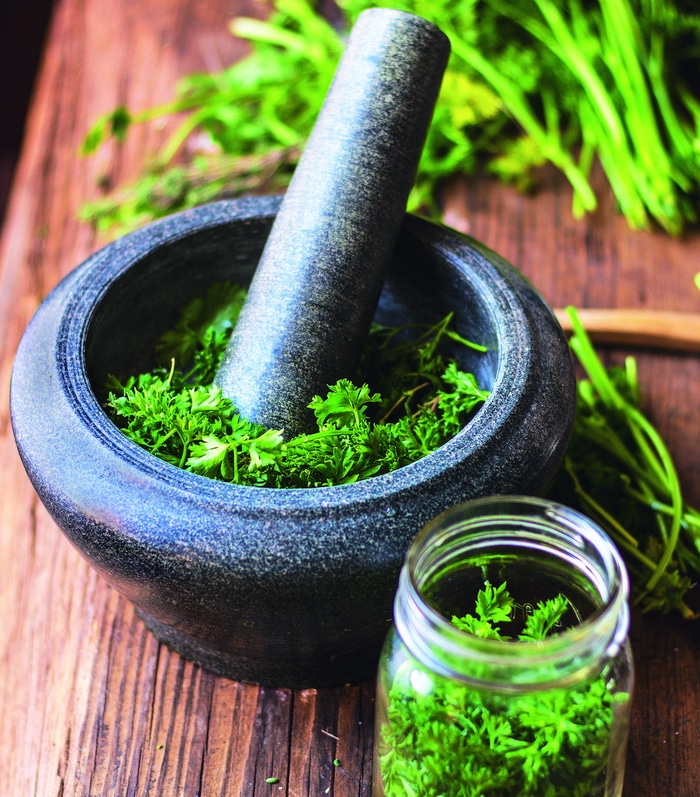
You can blend your favourite flavours together in the ferment. Try garlic scapes and bee balm, parsley and lemon balm. Herbal blends are useful for salad dressings, soup, sauces, dips, and egg dishes, where an extra punch of flavour can enhance the taste of fresh ingredients.
Since these are so quick to make, you can have several fermenting at once, as you bring herbs in from the garden. You’ll need fermentation weights and fermentation-lock lids plus mason jars for best results. The fermentation weights are especially helpful in this recipe because they hold the herb leaves under the brine and prevent mold.
These recipes can be found in Traditionally Fermented Foods, Innovative Recipes and Old-Fashioned Techniques for Sustainable Eating by Shannon Stonger (Page Street Publishing, 2017) and are used with permission of the publisher and the author. Find out more about this innovative book below.
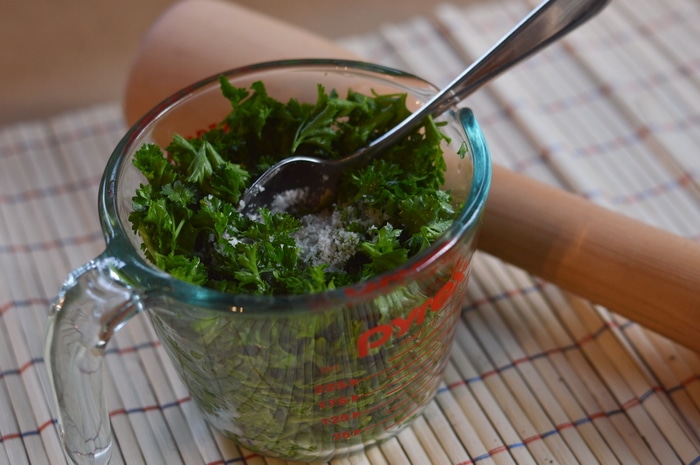
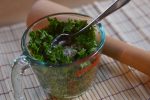
Brine Fermented Herbs Recipe
- Yield: 1 cup 1x
Ingredients
- 1 cup (40 grams) lightly packed, fresh whole herb leaves (any herb works here)
- 1 cup filtered water (avoid using chlorinated, fluoridated tap water)
- 1 teaspoon Celtic sea salt or Himalayan salt
- Fermentation weight
- Fermentation lid
Instructions
- Remove the herb leaves from their stems
- Wash and drain (A salad spinner is useful to get the excess water off of the herb leaves, but not essential)
- Pack an 8 ounce mason jar with herb leaves and flowers. Leave a small headspace
- Combine the filtered water and salt
- Pour the brine over the herbs in the jar
- Place a fermentation weight in the top of the jar to hold the herbs under the brine
- Place a fermentation lid on the jar, secure with a canning jar ring
- Place on a dish to catch any overflow
- Ferment for 5 to 10 days until the mixture stops actively bubbling and the brine is tangy
- Remove the fermentation weight and lid and replace them with a storage lid
Notes
- This will keep for several months at room temperature if left unopened
- This will keep for 1 to 2 weeks at room temperature once it is opened
- This will keep for up to 6 months in the refrigerator
Brine-Fermented Fresh Herbs
Yield: 1 cup
Ingredients:
1 cup (40 grams) lightly packed, fresh whole herb leaves (any herb works here)
1 cup filtered water (avoid using chlorinated, fluoridated tap water)
1 teaspoon Celtic sea salt or Himalayan salt
Directions:
Remove the herb leaves from their stems. Wash and drain. A salad spinner is useful to get the excess water off of the herb leaves, but not essential. Pack an 8 ounce mason jar with herb leaves and flowers. Leave a small headspace. Combine the filtered water and salt. Pour the brine over the herbs in the jar. Place a fermentation weight in the top of the jar to hold the herbs under the brine. Place a fermentation lid on the jar, secure with a canning jar ring.
Place on a dish to catch any overflow. Ferment for 5 to 10 days until the mixture stops actively bubbling and the brine is tangy. Remove the fermentation weight and lid and replace them with a storage lid.
This will keep for several months at room temperature if left unopened and 1 to 2 weeks at room temperature once it is opened. Store up to 6 months in the refrigerator or in a root cellar.
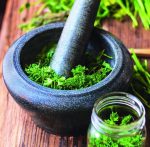
Fermented Herbs Paste Recipe
- Yield: ½ cup 1x
Description
Herb paste has a more intense flavour than brined herbs.
Ingredients
- 2 or 3 bunches of fresh herbs
- ½ teaspoon sea salt
- Fermentation weight
- Fermentation lock
Instructions
- Remove the herb leaves from their stems
- Wash and drain (A salad spinner is useful to get the excess water off of the herb leaves, but not essential)
- Chop the herb leaves finely
- Transfer to a small bowl and toss with sea salt
- Using a kraut pounder press herbs well to bruise them and release their juices
- Fill small ½ cup jars with chopped herbs
- Press the herbs to pack them snugly in the jars
- Check the jars for the level of brine
- If the brine hasn’t come up to the level of the herbs, add salt brine to a ratio of 2 teaspoons of salt to 1 cup of water, to just cover the herbs in the jar
- Weigh the herbs down with a fermentation weight
- Cover the jar with a fermentation lock
- Ferment for 5 to 10 days until the herbs are tangy
- Remove the fermentation weight and lid, and replace them with a storage lid
Notes
- Fermented fresh herb paste will keep for several weeks at room temperature
- Fermented fresh herb paste will keep for 2 to 3 months in a root cellar
- Fermented fresh herb paste will keep for up to 6 months in the refrigerator
- Green herbs will oxidize to black over time. This is a natural process and does not harm the final product or the shelf life of the herbs
Paste Fermented Fresh Herbs
Herb paste has a more intense flavour than brined herbs. Try them both and see which you like best.
Yield ½ cup
Ingredients:
2 or 3 bunches of fresh herbs
½ teaspoon sea salt
Directions:
Remove the herb leaves from their stems. Wash and drain. A salad spinner is useful to get the excess water off of the herb leaves, but not essential. Chop the herb leaves finely. Transfer to a small bowl and toss with sea salt. Using a kraut pounder press herbs well to bruise them and release their juices. Fill small ½ cup jars with chopped herbs. Press the herbs to pack them snugly in the jars. Check the jars for the level of brine. If the brine hasn’t come up to the level of the herbs, add salt brine to a ratio of 2 teaspoons of salt to 1 cup of water, to just cover the herbs in the jar. Weigh the herbs down with a fermentation weight. Cover the jar with a fermentation lock. Ferment for 5 to 10 days until the herbs are tangy.
Remove the fermentation weight and lid, and replace them with a storage lid.
Fermented fresh herb paste will keep for several weeks at room temperature, 2 to 3 months in a root cellar or up to 6 months in the refrigerator.
Author Shannon Stronger notes that “green herbs will oxidize to black over time. This is a natural process and does not harm the final product or the shelf life of the herbs.”
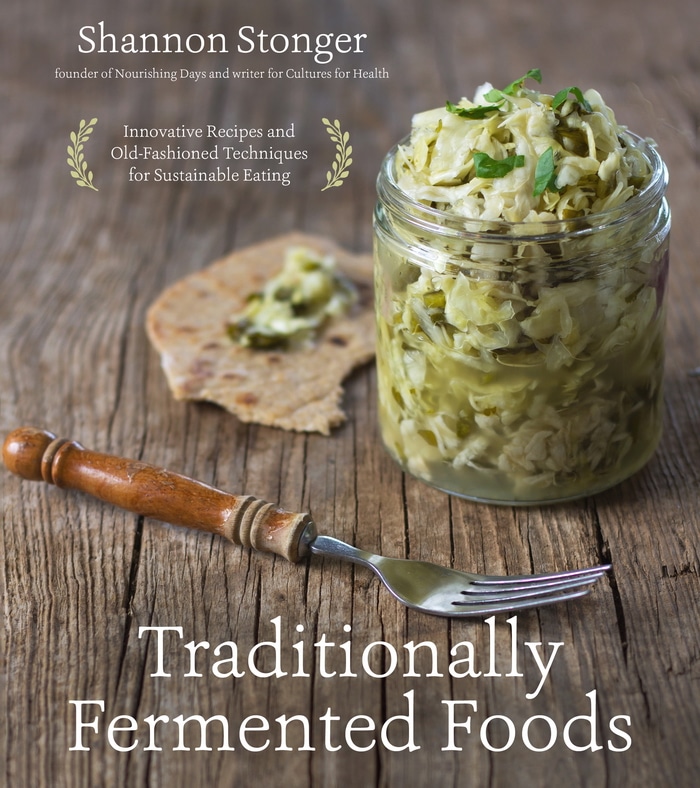
©2017, Shannon Stonger, Paige Street Publishing, used with permission.
About the book
Like all the books by Page Street Publishing, this book is stunning. The photography is enticing and the cover design is very attractive. The paper is high quality, too, making this a good gift choice for gardeners, homesteaders, and friends who are passionate about natural health and wellness.
Shannon Stonger is the writer behind the Nourishing Days blog and a contributing writer for Cultures for Health. She knows fermentation and she approaches it from an off-grid homesteading perspective, which I love. If you’ve been longing to learn the old fashioned ways of food preservation, the kind used before refrigeration, you’ll love this book. It has old fashioned knowledge with modern photography and standard recipe measures. You can’t ask for a better combination.
The book isn’t just pickles and pastes, either. There is an entire section devoted to sourdough, and another section focused on kefir and cultured dairy. But my favourite section of the book was the section on vegetables. Shannon offers a new look at some old favourites like homestead ‘chi, a kimchi variation and taco kraut and fruit kraut, two sauerkraut variations that will even please picky eaters.
The book finishes with a section on fermented drinks that are non-alcoholic. Sorry, no herbal mead or fruit wines in this edition. But Kvass, water kefir, and Kombucha are covered briefly.
The final section of the book showcases condiments that are enhanced by fermentation like hot sauce, salsa, mayonnaise, and mostarda (a recipe I’m going to tackle as soon as I have garden fresh zucchini this summer.)
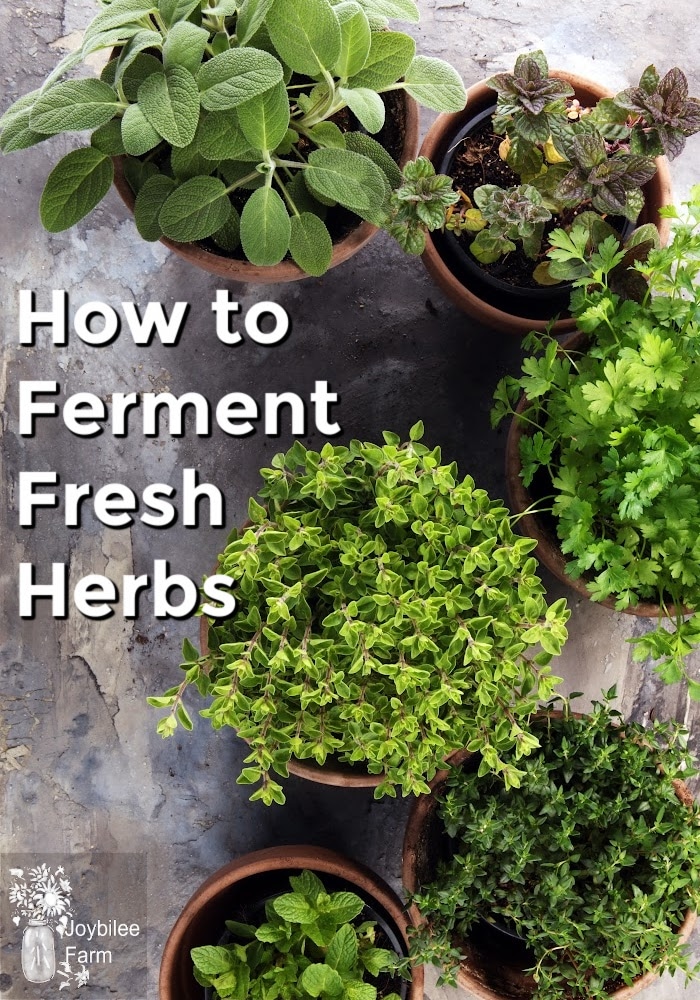
Homegrown and aromatic herbs in old clay pots. Set of culinary herbs. Green growing sage, oregano, thyme, parsley, mint and oregano.
If you are ready to explore fermentation in a deeper way or you are getting tired of making the same old kosher dills, lacto-fermented mustards, and sauerkraut and are ready to up your game, this book is your inspiration for going deeper into the mysteries of fermentation.
Get your copy now, before the summer garden is in full production and you yearn for fresh ideas for preserving the bounty. You’ll definitely find those fresh ideas here.
Disclaimer: I received a review copy of this book from the publisher. This review is my honest opinion of the book.


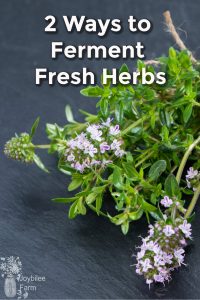


There must of been other contamination somewhere in the process. Dried herbs alone can’t mold. But once you introduce water mold is possible.
I tried using dried rosemary in a batch of brined pickles and they molded, but the batch I did with dill on the same day didn’t. Can dried rosemary normally be used or did I potentially unintentionally introduce something to that batch only?
If it smells fine and there is no mold, you’re ok with it. The brine does discolor because of the flavonoids in the herbs. Flavonoids are the color molecules in the plant.
The brine in my basil ferment is brown, is this normal?
Thank You